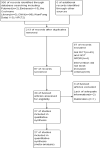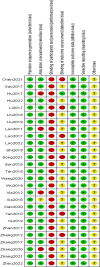Effect of Chinese herbal compounds on ocular fundus signs and vision in conventional treated-persons with non-proliferative diabetic retinopathy: A systematic review and meta-analysis
- PMID: 36034416
- PMCID: PMC9403050
- DOI: 10.3389/fendo.2022.977971
Effect of Chinese herbal compounds on ocular fundus signs and vision in conventional treated-persons with non-proliferative diabetic retinopathy: A systematic review and meta-analysis
Abstract
Background: Changes in fundus signs and loss of visual acuity are an important basis for screening and treating diabetic patients with retinopathy, and conventional Western medicine is moderately effective in treating diabetic retinopathy(DR),To systematically evaluate the effectiveness and safety of Chinese herbal compounds(CHCs) in the combined treatment of diabetic retinopathy.
Method: Six electronic databases, including PubMed, were searched to screen eligible literature. Randomized controlled trials of non-proliferative diabetic retinopathy(NPDR) were included, in which the control group was treated with conventional Western-based drugs or retinal laser photocoagulation, and the intervention group was treated with CHCs in combination based on the control group.The Cochrane Risk of Bias Assessment Tool was used to evaluate the quality of the literature, and the RevMan 5.4 software was used for statistical analysis.
Results: Compared with Conventional group alone,CHCs group was superior at improving clinical efficacy [RR=1.29, 95%CI=(1.23, 1.36),P<0.01] and best corrected visual acuity(BCVA) [MD=0.10,95%CI=(0.09,0.12),P<0.01],it was also superior at reducing the number of microangiomas [MD=-2.37, 95%CI=(-3.26, -1.49),P<0.01], microangioma volume [MD=-4.72, 95%CI=(-5.14, -4.29), P<0.01], hemorrhagic spots [MD=-2.05, 95%CI=(-2.51,-1.59), P<0.01], hemorrhagic area [MD=-0.76, 95%CI=(-1.06, -0.47), P<0.01], hard exudates [MD= -1.86, 95%CI=(-2.43, -1.28), P<0.01], cotton lint spots [MD= -0.93, 95%CI= (-1.31, -0.55), P<0.01], central macular thickness(CMT) [SMD=-1.52, 95%CI=(-1.85, -1.19),P<0.01], Chinese medicine evidence score [SMD=-1.33,95%CI=(-1.58, -1.08),P<0.01], fasting blood glucose (FBG) [SMD=-0.47, 95%CI=(-0.61,-0.33),P<0.01], 2h postprandial blood glucose(2hPBG) [SMD=-0.87, 95% CI=(-1.06, -0.67), P<0.01], glycosylated hemoglobin (HbAlc) [SMD=-0.76, 95%CI=(-1.16, -0.3),P<0.01], total cholesterol(TC) [SMD=-0.33,95%CI=(-0.51,-0.16),P<0.01],and CHCs group with less adverse events occurred [RR=0.46, 95%CI=(0.29, 0.74),P<0.01].
Conclusion: CHCs combined with conventional medicine for NPDR has better clinical efficacy and higher safety, but the above findings need further validation in more large sample, multicenter, and low-bias RCTs due to the limitation of the quality and quantity of included literature.
Systematic review registration: https://www.crd.york.ac.uk/prospero/, identifier CRD42022342137.
Keywords: Chinese and Western medicine combination; Chinese medicine compounds; diabetic retinopathy; meta-analysis (as topic); safety evaluation.
Copyright © 2022 Li, Zhang, He, Su, Li and Xie.
Conflict of interest statement
The authors declare that the research was conducted in the absence of any commercial or financial relationships that could be construed as a potential conflict of interest.
Figures










Similar articles
-
Effect of Chinese Patent Medicines on Ocular Fundus Signs and Vision in Calcium Dobesilate-Treated Persons With Non-Proliferative Diabetic Retinopathy: A Systematic Review and Meta-Analysis.Front Endocrinol (Lausanne). 2022 Mar 14;13:799337. doi: 10.3389/fendo.2022.799337. eCollection 2022. Front Endocrinol (Lausanne). 2022. PMID: 35370950 Free PMC article.
-
QiMing granules for diabetic retinopathy: a systematic review and meta-analysis of randomized controlled trials.Front Pharmacol. 2024 Aug 22;15:1429071. doi: 10.3389/fphar.2024.1429071. eCollection 2024. Front Pharmacol. 2024. PMID: 39239647 Free PMC article.
-
Monotherapy laser photocoagulation for diabetic macular oedema.Cochrane Database Syst Rev. 2018 Oct 15;10(10):CD010859. doi: 10.1002/14651858.CD010859.pub2. Cochrane Database Syst Rev. 2018. PMID: 30320466 Free PMC article.
-
The efficacy and safety of Chinese herbal medicine as an add-on therapy for type 2 diabetes mellitus patients with carotid atherosclerosis: An updated meta-analysis of 27 randomized controlled trials.Front Pharmacol. 2023 Mar 23;14:1091718. doi: 10.3389/fphar.2023.1091718. eCollection 2023. Front Pharmacol. 2023. PMID: 37033624 Free PMC article.
-
Systematic evaluation of combined herbal adjuvant therapy for proliferative diabetic retinopathy.Front Endocrinol (Lausanne). 2023 May 18;14:1157189. doi: 10.3389/fendo.2023.1157189. eCollection 2023. Front Endocrinol (Lausanne). 2023. PMID: 37274344 Free PMC article. Review.
Cited by
-
The effectiveness and safety of Chinese patent medicines plus calcium dobesilate for the treatment of diabetic retinopathy: A network meta-analysis.Heliyon. 2024 Jan 18;10(3):e24533. doi: 10.1016/j.heliyon.2024.e24533. eCollection 2024 Feb 15. Heliyon. 2024. PMID: 38333795 Free PMC article.
-
An evidence mapping study based on systematic reviews of traditional Chinese medicine (TCM) for diabetic retinopathy.Syst Rev. 2025 Feb 20;14(1):45. doi: 10.1186/s13643-025-02755-w. Syst Rev. 2025. PMID: 39980075 Free PMC article.
-
Efficacy comparison of multipoint and single point scanning panretinal laser photocoagulation in non-proliferative diabetic retinopathy treatment.World J Diabetes. 2024 Aug 15;15(8):1734-1741. doi: 10.4239/wjd.v15.i8.1734. World J Diabetes. 2024. PMID: 39192851 Free PMC article.
-
The Role of Natural Products in Diabetic Retinopathy.Biomedicines. 2024 May 21;12(6):1138. doi: 10.3390/biomedicines12061138. Biomedicines. 2024. PMID: 38927345 Free PMC article. Review.
-
Dilemmas in Elderly Diabetes and Clinical Practice Involving Traditional Chinese Medicine.Pharmaceuticals (Basel). 2024 Jul 16;17(7):953. doi: 10.3390/ph17070953. Pharmaceuticals (Basel). 2024. PMID: 39065801 Free PMC article. Review.
References
Publication types
MeSH terms
Substances
LinkOut - more resources
Full Text Sources
Medical

